Moto Z Review
Moto Z
When making a thin phone is a bad idea
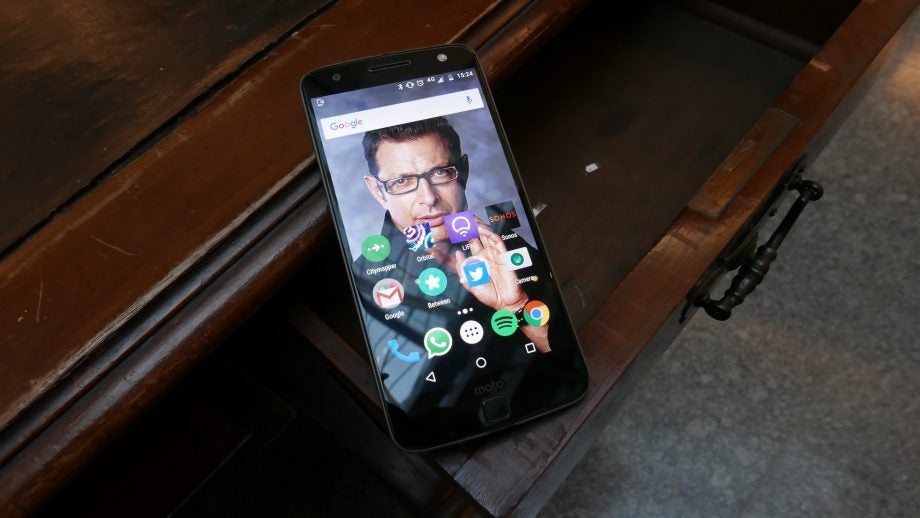
Sections
- Page 1 Moto Z Review
- Page 2 Software, performance, battery life and verdict Review
Verdict
Pros
- Big, high-quality display
- Great performance
- Respectable camera in good light
Cons
- Terrible battery life
- No headphone jack
- Disappointing low-light photos
Key Specifications
- Review Price: £499.00
- 5.5in Quad HD display
- 5.19mm thick (sort of)
- Modular Moto Mods
- Qualcomm Snapdragon 820 processor
- 4GB RAM
- 32GB storage (with microSD expansion)
- Android 6.0.1
- 13MP rear, 5MP front cameras
- 2,600mAh battery
What is the Moto Z?
At one point, it appeared as if modular smartphones were going to be all the rage. While they perhaps haven’t become as prevalent as many had expected (RIP Project Ara), it hasn’t stopped phones such as the LG G5 having a go at optional add-ons, with the forthcoming Lenovo smartphones pulling the same trick too.
Coincidentally, this brings us to the Moto Z – technically another of Lenovo’s smartphones, thanks to its acquisition of Motorola. This 5.5-inch phablet’s capabilities can be augmented by attaching add-ons via magnets located on the rear of the device. Think cameras, projectors, speakers and the like.
The Moto Z also happens to be incredibly thin – allegedly the thinnest smartphone ever – but that comes with both a caveat, and some serious shortcomings when it comes to battery life. In the famous words of Jeff Goldblum, “Motorola was so preoccupied with whether or not they could, they didn’t stop to think if they should”. At least that’s how I think the quote went.
Moto Z – Design
At 5.19mm, there’s no doubting this is an incredibly thin phone. But that caveat I just mentioned? You really won’t want to use a phone that’s this thin. The rear is glossy and picks up fingerprints aplenty, and with so little phone to actually grab, the Moto Z feels incredibly precarious in the hand – like trying to hold a jellied eel.
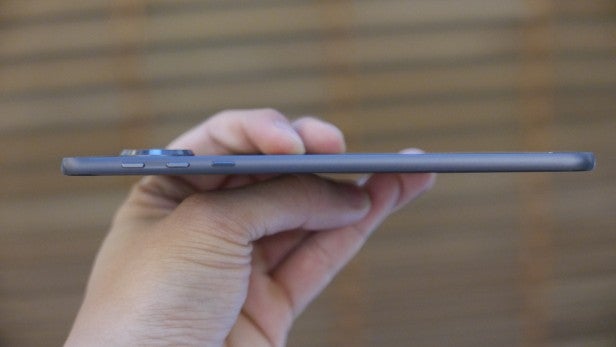
Then there’s the fact that the camera bump is particularly pronounced, so much so that the Moto Z will rest on it when placed down on a surface. In addition, the magnetic pogo pins used for attachments are exposed in a rather ugly way.
Related: Best Smartphones 2016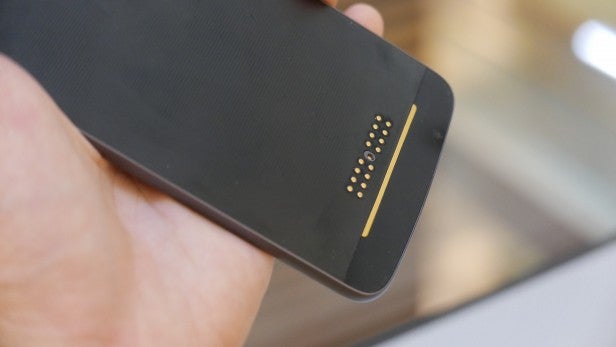
In fairness, Motorola doesn’t really want you to use the phone in this form anyway. A rear cover is included in the box, which attaches to the back with magnets in the same way as the optional Moto Mods. This brings the Moto Z’s thickness up to distinctly more standard territory, deals with the slippery back, and makes the rear camera sit flush.
So, in fact, calling the Moto Z the “razor-thin future of smartphones” feels rather disingenuous when no-one is likely to ever use it in that form. The covers – technically part of the Moto Mods range – are called Moto Style Shells and are available in a variety of materials and textures. My review model came with a charcoal grey shell with an almost denim-like texture to it. It feels nice in the hand and provides plenty of grip.
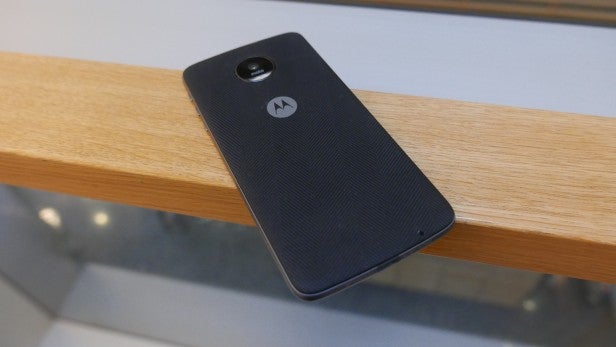
Other Moto Mods can attach to the rear, such as the Hasselblad camera add-on, or a pair of JBL speakers. While I haven’t tested any of the add-ons thoroughly to offer any real opinion on them, I can at least say the magnetic attachment is reassuringly strong. There’s no worry that a Moto Mod might become detached unintentionally at any point. The modular approach here is far more elegant than LG’s.
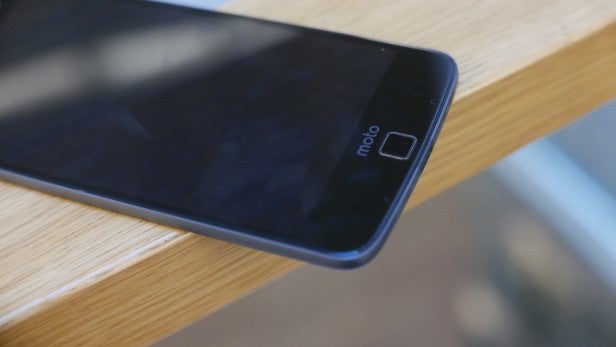
A fingerprint sensor can be found on the front of the phone, rather than on the back, which is my preference. It means I can unlock the phone when it’s lying on a table. The sensor sits below the screen and can be used to both unlock and lock the phone. For the first few days of testing the Moto Z, I instinctively kept pressing the sensor as if it were a home button, resulting in accidentally locking the screen.
Considering there’s so much space below the display, I wish that Motorola had actually made the fingerprint sensor the home button, with capacitive Android menu buttons on either side – similar to Samsung’s approach to Android phones.
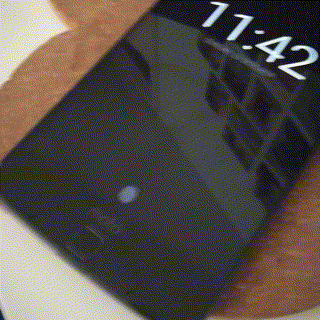
Still, I did eventually train myself to not keep touching it, and I found that locking the phone from the sensor is far more convenient than reaching for the power button on the side.
The fingerprint sensor is pretty responsive, only failing to register my fingerprints when my digits were covered in water, liquid chalk and peanut butter. Yes, all three were tested.
Viewing from the front, the Moto Z design doesn’t radically depart from the style of Motorola’s previous phones – the Moto X, for example.
Look to the bottom of the Moto Z and things are a little different, though. You’ll find only a USB Type-C port. Check the top and you’ll discover only the SIM tray. There’s no 3.5mm headphone jack anywhere to be seen, just like the Apple iPhone 7.
Related: Best Bluetooth headphones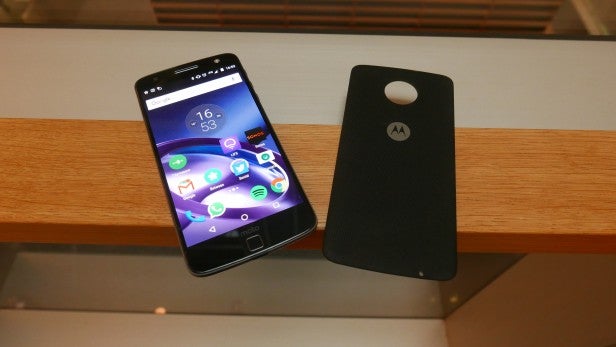
A USB Type-C to 3.5mm headphone adapter is included in the box to mitigate the lack of a port, but the missing jack feels like a greater omission here. At least with the iPhone 7, Lightning headphones might become more popular. Whether or not we’ll see USB Type-C headphones take off is another matter, so you had better not lose that adapter.
I went to use the Moto Z as my music source during a car journey and rued the fact I had left the adapter connected to my wired headphones at home. The lack of the headphone jack is likely to prove a pain.
Moto Z – Display
The 5.5-inch display is one of the Moto Z’s stronger features. It has a 2,560 x 1,440 resolution, which amounts to a tack-sharp 535 pixels per inch. It’s big, bold and vibrant, and makes viewing photos a particularly pleasant experience. Viewing angles are also very good.
I found the auto-brightness adjustment a little over-aggressive, with the display changing brightness when ambient light hadn’t fluctuated. I ended up just turning it off.
The speakers lack any real low-frequency presence, sounding particularly tinny. However, they’re able to reach a pretty respectable volume.
A special mention goes to the haptic feedback, which is particularly satisfying in the fingerprint sensor and on-screen Android menu buttons. The vibrations also work with certain games, too.
How we test phones
We test every mobile phone we review thoroughly. We use industry standard tests to compare features properly and we use the phone as our main device over the review period. We’ll always tell you what we find and we never, ever, accept money to review a product.


